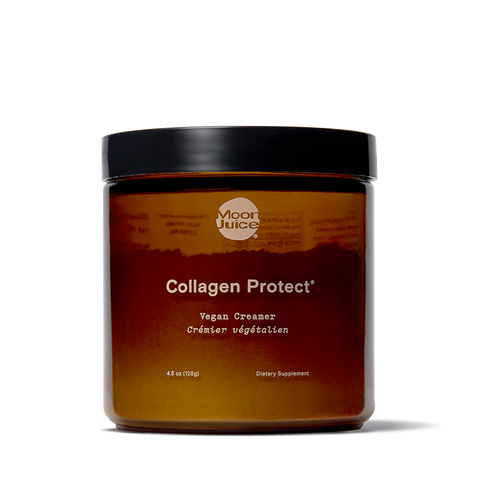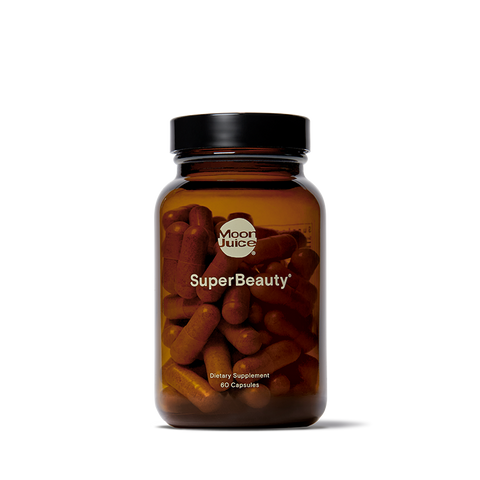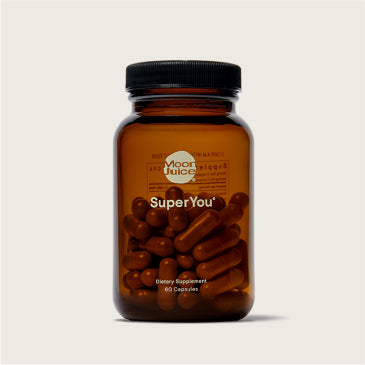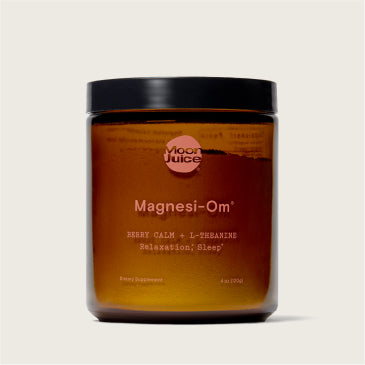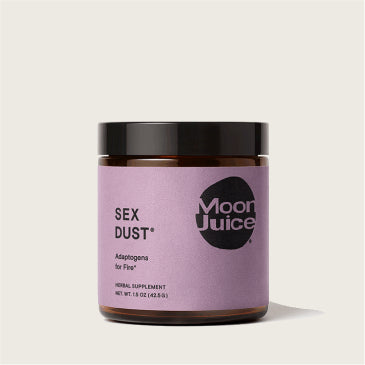Your skin has an innate ability to regenerate itself. But while this ability plays a role in making it bouncy and elastic, getting plump skin requires a holistic approach to skin health, from the product you use to the foods you choose to nourish your body with.
Skin care is more than just skin deep — it’s a routine that involves whole body health, including your gut.
If you’re wondering how to get plump skin from the inside out and outside in, read on.
What Makes Skin Look Plump?
Collagen, Hyaluronic Acid, and Elastin all play a role in supporting bouncy, plump skin. Each of these components exists naturally in your body and skin. And they work together to make your skin plump.
To stay plump, your skin also needs moisture, which helps prevent dryness that can make your skin look dull and unrested.
Your body also needs nutrients like Vitamin C, Zinc, and Amino Acids, to make collagen in the first place, making diet a crucial part of achieving plump skin.
In your 20s, your body’s Collagen, Hyaluronic Acid, and Elastin production declines, and your skin begins to lose these elements, which leads to loss of elasticity and wrinkles. But you can turn back the clock with a few lifestyle tweaks and skin care products and strategies.
Non-Surgical Ways to Make My Skin Look Plumper
Eat a Nutrient-Rich Diet
How can you make your skin look plumper? It starts with supporting skin health from the inside out.
Diet and skin health are closely linked. In fact, a whole-food, plant-based diet may actually play a role in reversing and preventing skin aging. Why? Because this type of diet typically contains way more skin-friendly antioxidants, like Vitamin A, C, and E, than other dietary lifestyles.
How does consuming an antioxidant-rich diet affect cellular skin aging? Your DNA chromosomes each have telomeres capping them off. They prevent DNA from unraveling and degrading. During the process of DNA replication, telomeres get shorter and shorter, and eventually die.
Evidence shows that some lifestyle factors might actually help lengthen telomeres by influencing the production of telomerase, an enzyme capable of rebuilding telomeres. In one study, for example, participants who ate a healthy, whole-food, plant-based diet were found to have longer telomeres after a 5-year follow-up compared to those who didn’t make any dietary lifestyle changes, whose telomeres noticeably shrank over time.
So while telomeres naturally shorten with age, you can lengthen them with a whole-food diet and other good habits, like yoga and stress management. Think of them like caps on the ends of shoelaces. They keep your DNA from fraying and decaying. Fewer frayed cells mean more healthy ones. And healthy cells are necessary for plump, youthful-looking skin.
Add Hyaluronic Acid to Your Skin Care Routine
Your body naturally produces Hyaluronic Acid, a gel-like substance that helps plump up skin. But your body produces less of it as you age, like it does with collagen.
One 2021 study found that participants who used HA twice daily, along with sunscreen, saw major improvements in the look of their skin, including improved smoothness, plumpness, and hydration, and fewer lines and wrinkles.
You can find natural Hyaluronic Acid in Plump Jelly, a face plumping serum that’s like a glass of water for your face. The formula hydrates to help keep skin bouncy using Hyaluronic Acid and PGA Peptides to hydrate around cells and Beet Amino Acids and Silver Ear Mushroom to lock in moisture. Adaptogenic Reishi mushrooms helps improve skin’s natural barrier function and Tocos (Vitamin E) helps protect skin from oxidative stress to preserve elasticity.
Eating foods that contain or support the production of HA can also benefit your skin. Some examples include:
- Leafy green veggies
- Nuts and seeds
- Citrus fruit
- Tubers like potatoes, jicama, and sweet potatoes
Get Plenty of Sleep
Collagen gives skin its structure and elasticity, so it has a bouncy, plump look and feel. Like the rest of your body, your skin has its own circadian rhythm. At night, your skin works hard to repair daytime damage from things like UV rays and pollution by repairing and replicating DNA. It also builds collagen. Poor quality or interrupted sleep can mess with the body’s ability to reset — and that goes for your skin, too. Your skin can’t make collagen as effectively if it’s regularly sleep deprived.
Since there’s a link between quality rest and new collagen production, making sure you’re sleeping well can support skin health. That might entail:
- Working on improving sleep hygiene by doing things like using blackout blinds in your bedroom or skipping screen time a few hours before bed.
- Reducing stress levels with meditation or yoga to help make it easier to fall asleep.
- Fueling your body with nutrients to support deep sleep and quality rest.
Getting enough rest is also crucial for skin health. Research shows that skipping out on shut-eye can impact skin appearance. One 2020 study of Korean women in their 40s found that fewer hours of sleep led to decreases in skin hydration and loss of skin elasticity over time.
Aim to get at least 7 to 8 hours of sleep per night not just to keep your skin looking vibrant, but to support your overall health and well-being.
Try Retinol
Another way to support collagen production is to use Retinol on your skin. Research backs the skin-friendly benefits of this form of Vitamin A, including an ability to minimize lines and increase collagen production. And dietary Vitamin A has been shown to play an important role in skin cell growth and development. Additionally, eating food sources of Vitamin A can help protect you from the sun’s potent UV rays.
Exfoliate Regularly
Regular exfoliation can help slough off dead skin cells, removing build-up and encouraging cell turnover. By getting rid of old skin cells and grime, you make room for brand-new skin cells to emerge, creating brighter, more youthful-looking skin.
While physical exfoliants can help remove dead cells on the skin’s surface, harsh scrubbing due to mechanical exfoliation can lead to micro-tears and inflammation.
Chemical exfoliants, like Alpha Hydroxy Acids (AHAs) and Beta Hydroxy Acids (BHAs), may produce less skin irritation and can target dirt and grime deep inside your pores. Consider adding one to your routine 2-3 times a week after you wash your face with a gentle milky cleanser.

Apply SPF
Did you know that UV rays can break down collagen? The resulting damage impacts skin elasticity and can pave the way toward more lines and wrinkles. This is why skin in areas frequently exposed to the sun, like the face, neck, and hands, tends to age faster than skin that’s usually covered by clothing. If you don’t protect your skin from the sun’s powerful rays with SPF products, it will age at an accelerated rate and rapidly lose its plumpness.
When choosing a sunscreen or SPF-containing product like a moisturizer, look for one that’s mineral instead of chemical-based. In addition to being more eco-friendly than chemical products, mineral sunscreens are less toxic than chemical ones, instantly block out the sun (unlike chemical sunscreens which need to absorb into the skin first), and ideal for sensitive skin types.
Get Moving and Exercise
We don’t need to be convinced of the health benefits of exercise. They’re well-documented, and if you’ve ever been to a yoga class or gone for a run, you’re probably well-acquainted with the feel-good abilities of getting sweaty.
But were you aware that it can do your skin good, too? It does this in two ways.
By increasing the circulation of oxygen-rich blood, physical activity helps flood your body, and skin, with nutrients, providing skin cells the fuel they need to give you a glowy look.
Plus, exercise may also reverse mitochondrial changes in muscle that lead to skin aging. Mitochondria are the engines of your cells that produce a chemical called ATP, which fuels everything a cell does. When you get a cut and your skin repairs itself, that’s mitochondrial ATP at work. ATP is also necessary for making skin-plumping collagen and HA. As you age, your cells make less ATP.
But research suggests that working out might help prevent mitochondrial aging that leads to reduced ATP production.
See a Dermatologist
Some dermatology procedures, like injectable fillers, Botox, and skin peels, offer quicker, more noticeable results than using products at home. Keep in mind that these quick fixes don’t provide permanent results or address the underlying issues that can affect skin health, like hydration, a nutrient-diet, and quality rest.
Supplements That Make Skin Look Plump
Another way to achieve supple skin is supplementing. While eating a healthy diet full of nutrient-rich foods is essential for nourishing your skin, supplementation can help you achieve optimal nutrition and support healthy collagen production by filling in gaps in your diet.
Collagen supplements, for example, are designed to provide your body with the nutrients it needs to build collagen and restore elasticity to your skin. Collagen Protect® is a vegan collagen creamer and skin supplement formulated with 3 vegan ingredients to help protect and preserve your natural collagen.*
Vitamin C, a nutrient multitasker, is also critical for skin health. A lack of Vitamin C can even slow down wound healing and collagen formation. A systematic research review from 2018 suggests that Vit C might play a role in increasing collagen production. And getting plenty of it might also help your skin stay hydrated and wrinkle-free. Find it in SuperBeauty® skin care capsules, the master antioxidant formula that helps protect cell health for visible benefits, promoting collagen production and skin elasticity.*
Sources
- Al-Atif H. (2022). Collagen supplements for aging and wrinkles: A paradigm shift in the fields of dermatology and cosmetics. https://www.ncbi.nlm.nih.gov/pmc/articles/PMC8824545/
- Antille C, et al. (2003). Vitamin A exerts a photoprotective action in skin by absorbing ultraviolet B radiation. https://www.sciencedirect.com/science/article/pii/S0022202X15304954
- ATP. (n.d.). https://www.nature.com/scitable/definition/atp-318/
- Collagen. (2021). https://www.hsph.harvard.edu/nutritionsource/collagen/
- DePhillipo NN, et al. (2018). Efficacy of vitamin C supplementation on collagen synthetic and oxidative stress after musculoskeletal injuries: A systematic review. https://www.ncbi.nlm.nih.gov/pmc/articles/PMC6204628/
- Draelos ZD, et al. (2021). Efficacy evaluation of a topical hyaluronic acid serum in facial photoaging. https://pubmed.ncbi.nlm.nih.gov/34176098/
- FDA advances new proposed regulation to make sure that sunscreens are safe and effective. (2019). https://www.fda.gov/news-events/press-announcements/fda-advances-new-proposed-regulation-make-sure-sunscreens-are-safe-and-effective
- Hood DA, et al. (2019). Maintenance of skeletal muscle mitochondria in health, exercise, and aging. https://www.annualreviews.org/doi/abs/10.1146/annurev-physiol-020518-114310
- Jang SI, et al. (2020). A study of skin characteristics with long-term sleep restriction in Korean women in their 40s. https://pubmed.ncbi.nlm.nih.gov/31692145/
- Kahan V, et al. (2010). Can poor sleep affect skin integrity? https://www.sciencedirect.com/science/article/pii/S030698771000246X?via%3Dihub
- Matta MK, et al. (2020). Effect of sunscreen application on plasma concentration of sunscreen active ingredients. https://jamanetwork.com/journals/jama/fullarticle/2759002
- Pérez-Sánchez A, et al. (2018). Nutraceuticals for skin care: A comprehensive review of human clinical studies. https://www.ncbi.nlm.nih.gov/pmc/articles/PMC5946188/
- Pullar JM, et al. (2017). The roles of vitamin C in skin health. https://www.ncbi.nlm.nih.gov/pmc/articles/PMC5579659/
- Rittie L, et al. (2015). Natural and sun-induced aging of human skin. https://www.ncbi.nlm.nih.gov/pmc/articles/PMC4292080/
- Solway J, et al. (2020). Diet and dermatology: The role of a whole-food, plant-based diet in preventing and reversing skin aging—A review. https://www.ncbi.nlm.nih.gov/pmc/articles/PMC7380694/
- Sunscreen FAQs. (n.d.). https://www.aad.org/public/everyday-care/sun-protection/shade-clothing-sunscreen/sunscreen-faqs
- Zasada M, et al. (2019). Retinoids: Active molecules influencing skin structure formation in cosmetic and dermatological treatments. https://www.ncbi.nlm.nih.gov/pmc/articles/PMC6791161/

-(1).png?v=1680097423618)
.png?v=1680097439334)


